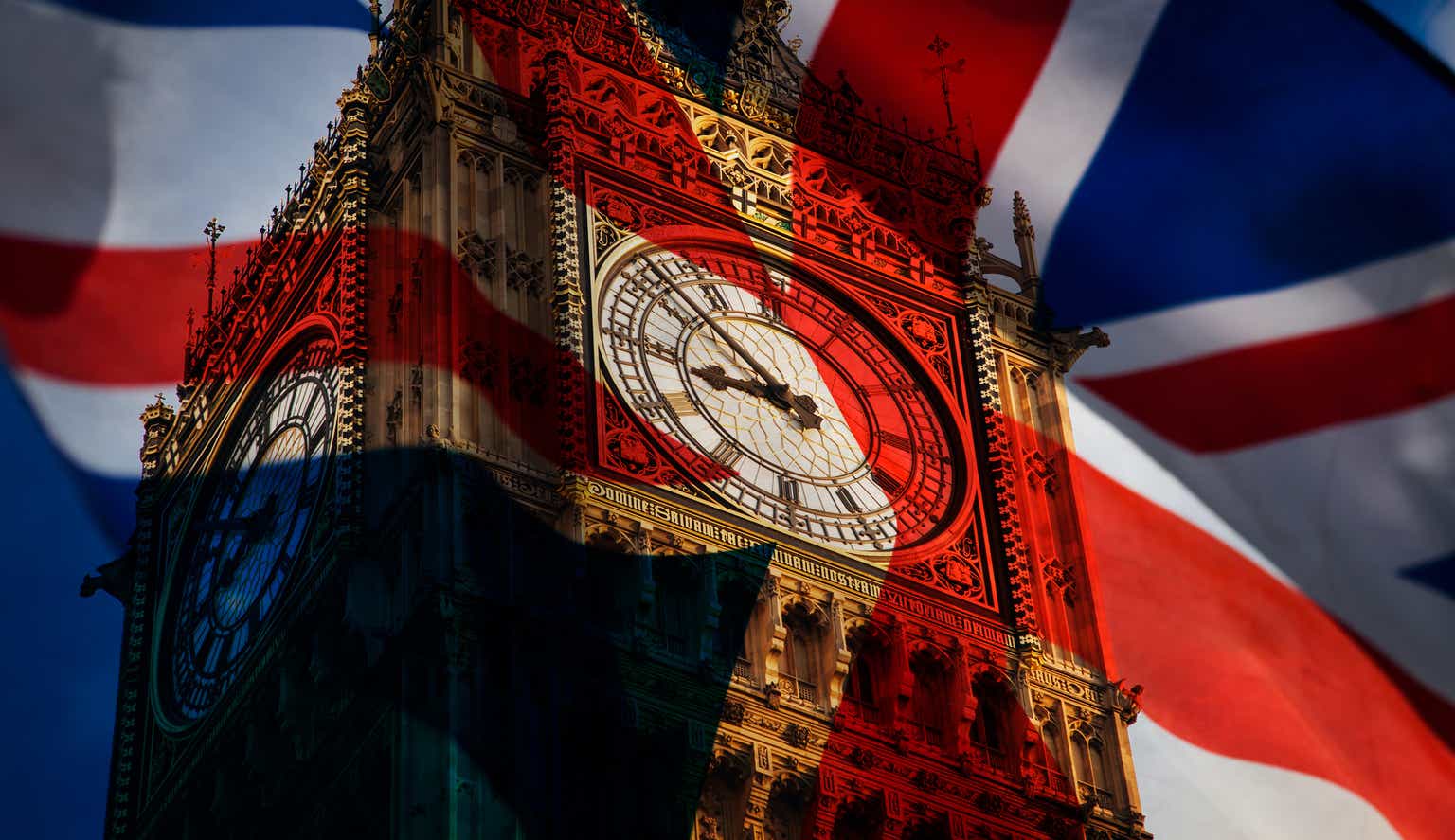By James Smith, Developed Markets Economist, UK; Michiel Tukker, Senior European Rates Strategist; Benjamin Schroeder, Senior Rates Strategist; and Francesco Pesole, FX Strategist
UK exit polls predict a landslide win for Keir Starmer’s Labour Party and humiliation for the ruling Conservatives under Prime Minister Rishi Sunak. While the result has been largely ‘baked-in’ given the opinion polls, the new government faces enormous financial and fiscal challenges.
A political earthquake has struck the UK after its election
The UK has voted, the exit poll is in, and the result looks clear: Labour will govern with a significant majority for the next five years. If that exit poll is accurate – and history suggests it will be – Labour is on course for a majority of around 170 seats. The incumbent Conservative party, gifted with an 80-seat majority at the last election in 2019, is projected to see its seats fall to just 131 from 365 five years ago.
Financial markets are, not surprisingly, unmoved, given that opinion polls have barely budged since the election was called six weeks ago. The pound did not react at all to the exit poll.
In stark contrast to political events across the channel in France, the UK’s election has looked like a foregone conclusion for months. This lack of market volatility is a welcome change after successive episodes of political turmoil.
It’s also a marked difference to the last election in 2019, where financial markets had to contend with uncertainty about the UK’s future EU trading relationship, the tail-risk of a second Scottish referendum, as well as some bold pledges on fiscal policy. None of that has been true in this campaign.
Of course, investors have not forgotten the 2022 ‘mini budget’ crisis and the unfunded tax pledges that caused an alarming stir in gilt markets. Since then, the risk premium for gilts has come down considerably. There’s a recognition that UK politicians are likely to tread carefully around bond markets, whoever prevailed in this election.
Labour’s public finances challenge is sizeable
Yet, the challenges facing the UK public finances have not disappeared. Elevated gilt yields reflect the fact that public debt is within spitting distance of 100%, and the deficit is at 4.4%.
Global bond investors have turned more sensitive to fiscal sustainability these past few months, and there’s a sense that Labour will inevitably need to go beyond what it promised during the campaign. The party has been clear that it wants to avoid further austerity. But the party’s promised revenue raisers amount to less than half a percent of GDP. And Labour has ruled out raising taxes that account for 80% of government revenue.
Growing the economy, a central Labour pledge, is unlikely to deliver the goods either, even if prospects are improving. Second quarter growth is likely to come in at a healthy 0.4-0.5% after a punchy 0.7% in the first quarter. Whether this will continue over successive years is much more questionable.
It’s not us that the government needs to convince; it’ll need to persuade the independent Office for Budget Responsibility (OBR) that its plans mean higher productivity and a brighter economy. That’s the key to unlocking more cash under the fiscal rules.
The issue is that the OBR’s growth forecasts already look too optimistic. If anything, those projections could end up being downgraded, reducing the incoming Chancellor’s manoeuvrability yet further.
Remember the OBR said in March that on current plans, the government would meet its fiscal rules by just £8bn. That’s a rounding error in the context of the UK’s public finances, and the rise in market interest rates since March will have further diminished that number.
Labour has more options than you might think
The challenge is big, but it would be wrong to say that Labour has no options. In fact, the new government might find it easier to find extra cash in its first budget than many think.
We’ll look at these options in more detail when the election results are in. But in short, small edits to the fiscal rules and several tweaks to minor taxes and associated reliefs could deliver the money needed to end planned cuts to spending.
Those cuts look set to exceed 3% a year in real terms for unprotected government departments, and many economists think that’s unrealistic given the existing strains on services. Ending those cuts will cost in the region of £20bn a year.
Finding that number is doable, but that simply maintains the level of real-terms spending. A more ambitious approach to government services, given the long-run challenges of an ageing population and an ailing healthcare system, would require more money to be found.
More significant tax rises may be unavoidable, though perhaps not this year. The incoming Labour government will also be tempted to borrow more to finance investment, and the manifesto committed to £3.5bn of just that. That’s a drop in the ocean, but a statement of intent nevertheless.
Labour is clearly treading carefully, given how markets reacted in 2022 to additional borrowing plans to finance tax cuts. But we suspect investors would be more accepting this time around, assuming, of course, that extra borrowing is intrinsically linked to productive infrastructure investment and is done through a clear framework.
Election result gives green light to August rate cut
All of that will keep the incoming Chancellor busy in the coming weeks. And expect Britain’s first-ever female Chief Finance Minister, Rachel Reeves. In the meantime, the absence of seismic changes to the public finances means the Bank of England can get on with the job of cutting interest rates. Markets are pricing a 60% chance of an August rate cut, and we think that’s too low.
BoE officials have been barred from public comments during the campaign, and that helps explain why UK rates have largely tracked price action in the US. But watch out for comments from BoE rate-setters next week, which might seek to boost expectations for an August cut.
Don’t forget that some policymakers thought the decision was finely balanced at the most recent June meeting, and the BoE has played down recent upside surprises to inflation. We expect three rate cuts this year, starting in August, which is more than markets are currently pricing.
If Labour’s fiscal plans don’t raise alarm bells among investors, and the BoE can indeed start cutting later this year, then 10-year gilt yields could end the year well below 4.0%. The further compression of any remaining risk premium related to fiscal uncertainty would help bring yields down. So too, will concerns about the global growth outlook.
FX: Pound untouched, BoE easing still points to sterling drifting down
The pound did not move at all as exit polls were published at 10pm BST, a testament to how fully priced-in a Labour landslide win was. Even if Keir Starmer’s party were projected to secure fewer seats than the pre-election polls had suggested, the parliament majority is so wide that markets are understandably disregarding the slightly softer result.
Bank of England policy plans remain the most important domestic driver for the pound, and our call for an August cut (16bp priced in) is the main reason for expecting a weakening in the sterling.
When it comes to the medium and long-term currency considerations, the budget restrictions the new government will face suggest a weakening of economic fundamentals for the pound and some depreciating pressure.
For now, both EUR/GBP and GBP/USD are fairly valued according to our Behavioural Equilibrium Exchange Rate model; when considering also the absence of political risk premium into this election, there is no technical hindrance to a moderate GBP depreciation.
Our call remains for a move to 1.25 in Cable and to 0.86 in EUR/GBP on the back of the Bank of England easing this summer. The risks to those two calls mostly stem more from a potentially weaker USD, due to softer US data, for example, or a weaker EUR (not least given the state of EU politics), and less from a round of idiosyncratic sterling strength, at least in our view.
Content Disclaimer
This publication has been prepared by ING solely for information purposes irrespective of a particular user’s means, financial situation or investment objectives. The information does not constitute investment recommendation, and nor is it investment, legal or tax advice or an offer or solicitation to purchase or sell any financial instrument. Read more
Original Post
Editor’s Note: The summary bullets for this article were chosen by Seeking Alpha editors.
Read the full article here










Leave a Reply